What I learned at the Civil Rights Museum / MLK
The hotel where Martin Luther King, Jr. was assassinated on April 4th 1968, is now the primary site of the National Civil Rights Museum, and it is a powerful place. The sign to the hotel and its exterior is preserved for history, the interior thoughtfully converted into a modern museum space. I visited for the first time recently during a road trip through the South of the U.S.
Before the trip I knew the basics of the civil rights movement in America, but was surprised at how much I didn’t know. I’ve had this experience about history before, but it never prevents me from having it again. We always think the major events are enough to help us understand something, but then you dig in and discover how much went on before those major events.
A stop at the Birmingham Civil Rights Institute two days before broadened my knowledge. There were many more people who made sacrifices and took personal risks than I realized (Fred Shuttleworth’s story was particularly powerful), and the struggle lasted far longer. The effort not only to raise awareness, but to find support was slow, painful, and plagued by brutal setbacks.
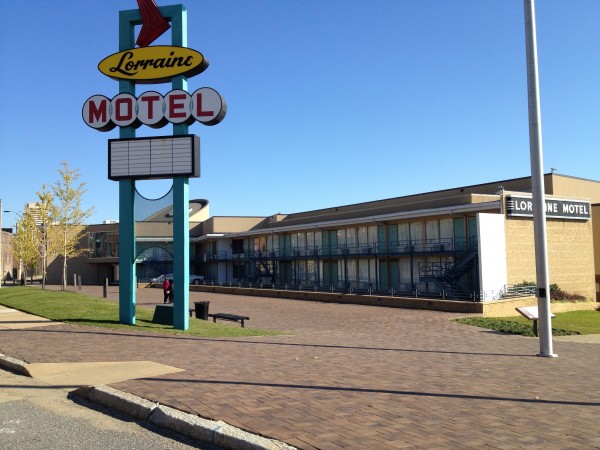
I expected, given its location, that the National Civil Rights museum would center on the story of Martin Luther King, Jr. But it was clear in the first few minutes that there were several decades of important developments that led up to the rise of MLK visibility.
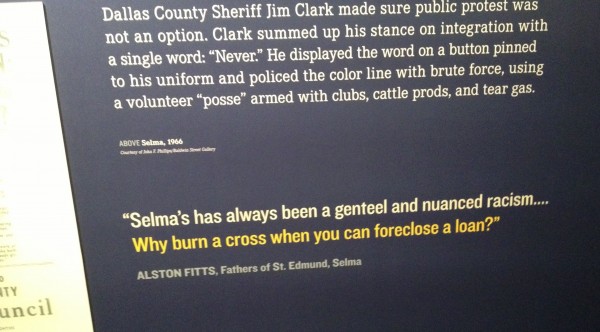
The many dimensions of racism and how proud some town leaders were of their outward defiance of any semblance of civility was disturbing. “Why burn a cross when you can foreclose a loan?” expresses such clear intelligence about what they were doing (economic intimidation). Even if you didn’t agree with these attitudes they were flaunted publicly and pervasively. Who could be brave enough to stand up against this kind of open harassment?
Segregated schools, given their own section in the museum, made clear how racism wasn’t just about the current generation, but also was applied to children, and therefore, the future. How do you divide children? I stood in that room and wondered how lost a people could be to so clearly take opportunities away from future generations. My 21st century eyes struggled to see this in a way that didn’t make me sad for humanity, as much as I didn’t want to see it that way. How do we do this to each other? How have we done this to each other for centuries? It’s impossible not to walk through the museum without feeling mystified about the human species. I’ve felt similar thoughts in Holocaust museums and at WWII sites (See What I Learned in Hiroshima). There is a brutality in our history and in us that we haven’t evolved past, if we ever will.
As I walked through the museum the big question I asked was: what would I do? In every story of awful behavior, vicious cruelty, and repression of ideas, I tried to imagine how I’d respond if I were a victim. What action would I take? Would I have done a sit-in at Woolworth’s? Would I have protested peacefully? Would I have gone on a Freedom ride? How civil would I be? Would I have been violent? Where? How? How brave would I be, and what would that word even mean? Or would I hide and ignore the whole thing?
And with each step I took from room to room I felt waves of respect for how many people were willing to make sacrifices to make arguments for rights that should have already been theirs (“”I’m tired of marching for something that should have been mine at birth” -MLK). I really don’t know what I would do. I can’t know. But I can try, today, to do something for the causes I believe in and injustices I see.
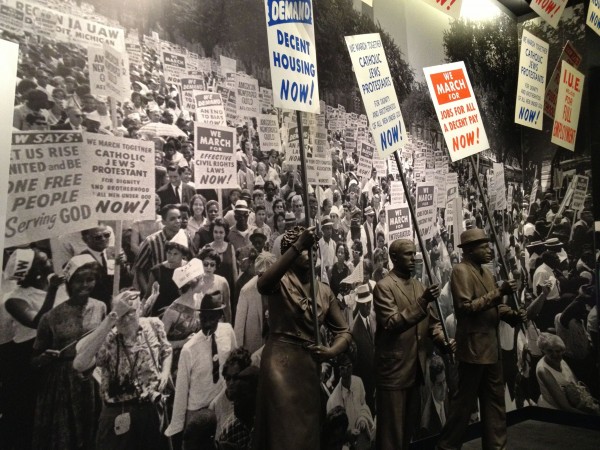
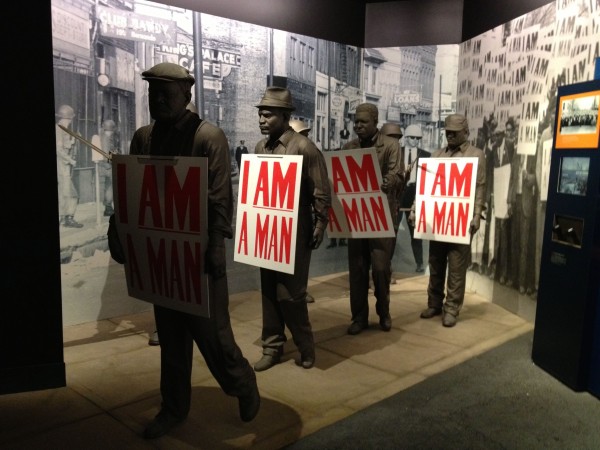
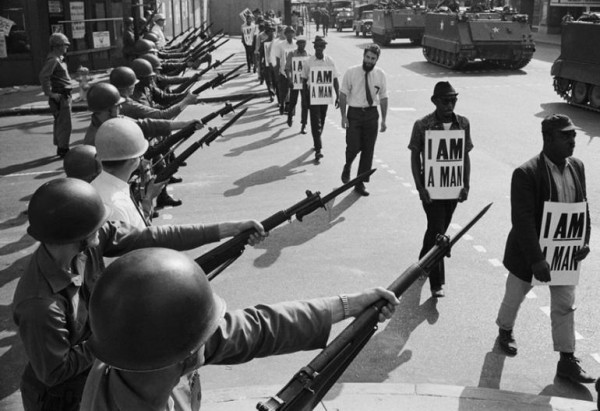
Out in the streets of Memphis are a series of murals, and had I not gone to the museum I wouldn’t have completely understood what they were about, and how they fit into the larger story.
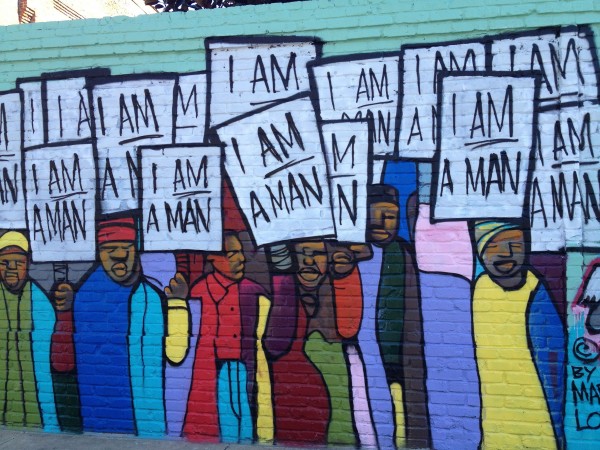
The famous stories like Rosa Parks, a story I’d learned as a child, always seemed like a singular event in my memory. As did MLK’s I have a dream speech. But it was only during the second half of the experience at the museum before either one was mentioned.
It took years of work and sacrifice before Parks’ protest for there to be enough of a story for hers to get broad attention and have the wider effect it had. The story of Fred Shuttlesworth, a name I first learned in Birmingham, came up many times in the museum, and I was inspired again by his intelligence and courage.
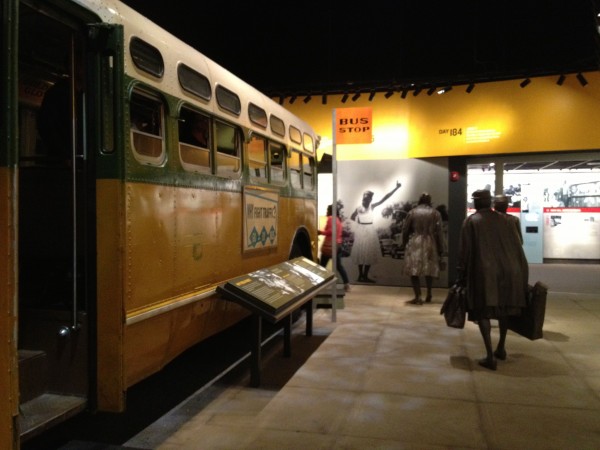
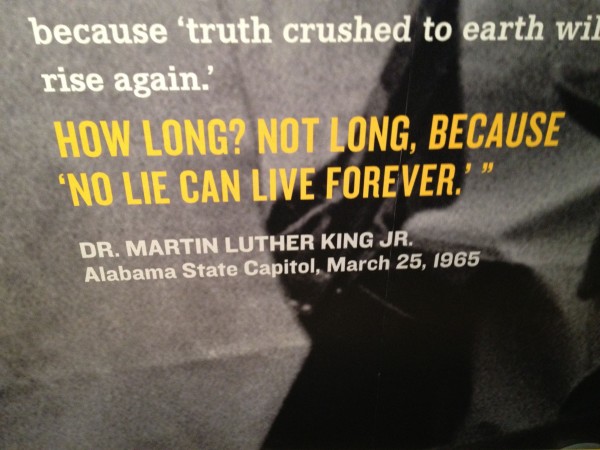
Its only towards the end of the story that MLK comes into central focus. In the movement he was a major wave, not the ocean itself, and as obvious as this sounds now, until I’d walked through the museum I’d never had that perspective before, or had it so clear in my mind. The role of the FBI and other government organizations in harassing black leaders was sad too, another reminder of what the status quo was like in the 1960s and how if we believe in progress, there is always something worth improving in any status quo.
From outside on the street there’s a plaque just beneath room 306. I watched many people stop to take a photo of this most famous and tragic place, and then walk on. Like me, before I went inside, I knew this was a horrible and important moment in history, but I didn’t fully understand. I felt sad for the people who moved on without going into the museum. They were in a historic place, but didn’t understand the history that led to that day.
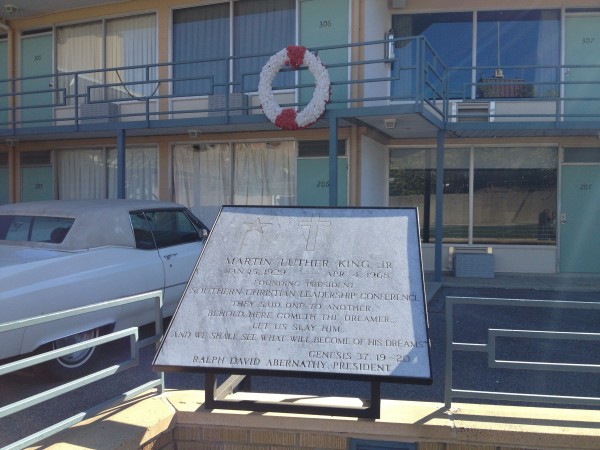
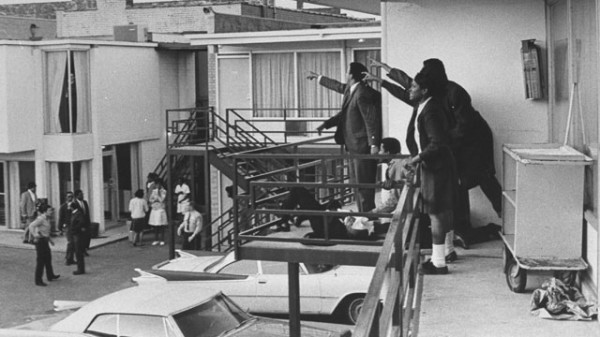
Standing in the room itself you can’t help but look across the street to where the rifle was fired that killed MLK. It seems so close and so quaint, and it was. There was an ordinary, neighborly grace of civility violated here. It’s an ordinary street, with ordinary buildings, made extraordinary for horrible reasons.
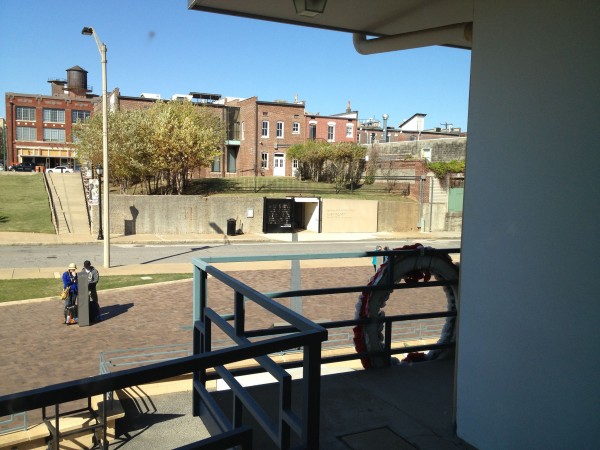
The museum continues across the street, and you can look the opposite way towards the hotel, out the apartment window where the shots that killed MLK were fired. It was not a hard shot to make. The cruelty of it is made worse but how peaceful this place is now and must have been then.
There is a marker in the street that quietly expresses where the shot traveled. It’s a silent, dark memorial, that some visitors might not notice.
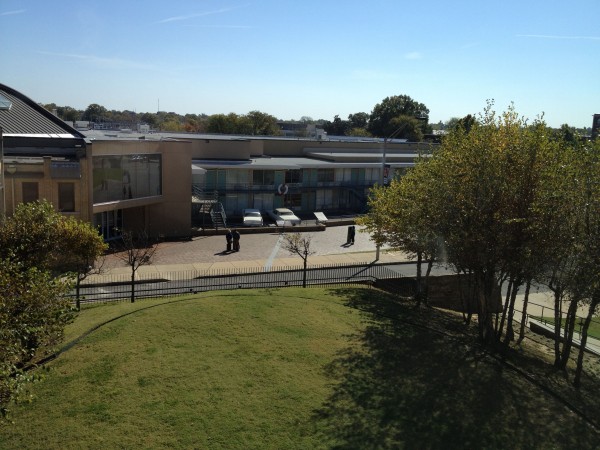
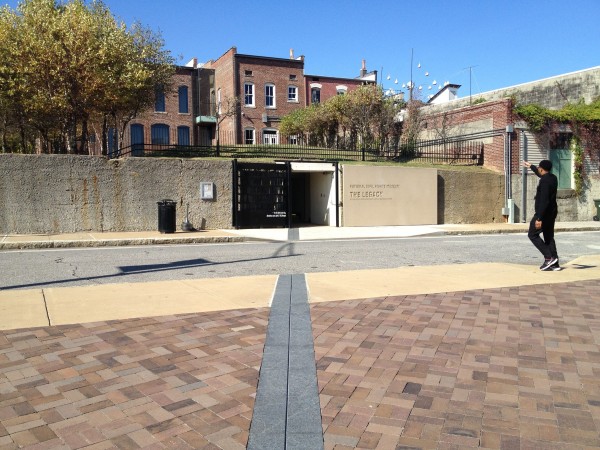
Standing in the window was a morbid and disturbing place to stand. I felt obligated to look and to stop for a moment. I thought about what the world would be like if there was never a reason for a museum like this to exist at all, much less in this specific place. I’m still mystified by how anyone can want to hurt someone who is a leader of a non-violent movement. It’s only cowards, filled with hate they don’t understand, that can act this way.
The museum ends with questions and the idea of community. I like that word. I like the idea of people creating a shared place together where everyone has an approximation of equal opportunity, and everyone contributes to doing what they can to help their neighbors, in the broadest sense of the word.
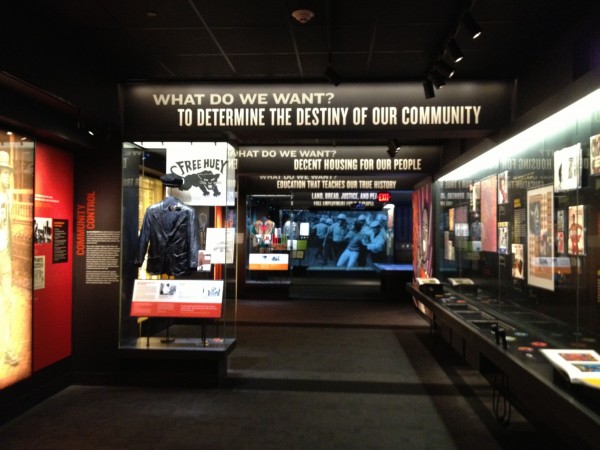
I strongly recommend visiting the museum. It will put everything going on today in America in a wider, deeper context, which can only help you sort out your feelings and what you want to do or not do about them. There’s so much history we, collectively, have yet to learn from.
- What would you have done then?
- What will you do about injustice now?

Excellent. Thank you.
“Our lives begin to end the day we become silent about things that matter.”
Martin Luther King Jr.
Thanks Scott for putting together this detailed and thoughtful post. It has brought me long forgotten memories about places in Europe (e.g. Sachsenhausen concentration camp) with similar dosis of hatred and brutality. These places should be preserved, visited, explained and… publicly discussed in venues like your blog. Thanks again for your courage.
I know people in this country prefer not to talk about history. Somehow makes conversations one-sided or a bit uncomfortable after a while. I think we all have to move beyond our comfort-zones and get a closer look to the human condition… pause, reflect, learn a lesson or two and get back to our times (where similar battles are still being fought).
Pablo
Thanks Pablo – appreciate you leaving a note that this post was meaningful to you.
Over the years I’ve visited the Dachau concentration camp, Babi Yar in Ukraine and other similar places – I’m Jewish by heritage and even though I’m an atheist if I were alive at the time these places became infamous my beliefs would be irrelevant – simply because of my blood I’d have been rounded up and killed.
Standing in those places moved me deeply as in my imagination I considered how unfair it all must have seemed. And I carry that sense of unfairness every time I go to place or hear a story of people treated so cruelly for reasons that have nothing to do with who they are.
History is a funny thing – people do talk about what they “think” history is (e.g. all the convenient references to “the founder fathers wanted this or that”), but it’s based on the scattered recollections they have from when they children, presented with a child’s version of history. A history they never revisit or review, and are therefore prone to all kinds of bias.
It’s also interesting how there are traditions in the U.S. for visiting places about difficult history – I did see school children at the Civil Rights Museum. But I wonder if they’re too young to emotionally connect with what they’re seeing. Even at Dachau I saw teenagers joking around and taking silly photos – It was hard to be outraged. If I were a teenager I bet I’d have done some of the same things. Bringing children is a start – it’s some level of exposure to history and horror, but we may need to be adults to think through all of the circles that leads people to do horrible things to each other.
https://www.youtube.com/watch?v=LIFxbOZezhE
I’m black. I watch little black boys play daily in my country Barbados with a freedom and abandon that it seems many little black boys in some parts of the US have never or rarely experienced. What is it about America that makes it so obviously and overtly violent? What is it about America that makes it appear to us outsiders so patently racist? I know that’s a crass generalisation. Not all Americans are racists. Not all are violent. Nevertheless, of the many, those are two the negative images that we have of America. Surely all stereotypes are bad. Why is much of that violence and hatred – racial profiling is directed towards black people – even by those responsible for their protection? That term doesn’t exist in the average Barbadian’s vocabulary but it seems to be pretty current in the US. Why are extra judicial killings of blacks justified in the American legal system ? Why do so many ordinary Americans support them. Our country experiences racism too. But modern day sophisticated lynchings ended here long ago. We tend to follow this history of racism in the US closely because America somehow is supposed to influence progress in the world. But little black boys here can walk freely, whereas in the USA, a country we watch for social, moral and political leadership, they are randomly profiled and killed? The justice meted out never seems to fit the crime. What is it about America that keeps racism so deeply entrenched?
“Few will have the greatness to bend history itself. But each of us can work to change a small portion of events; and in the total of all of those acts will be written the history of this generation.” Robert F Kennedy. (Thanks Scott Berkun. A very moving and heartfelt piece that touched me profoundly.)